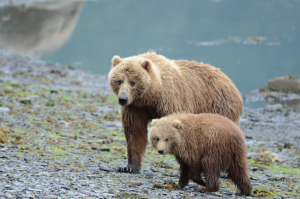
This week I am posting the first of my three-part series on Kodiak Bear Tales. I love the fact that I live in the midst of one of the largest brown-bear populations in the world, but knowing I could run into one of these large, furry creatures any time I take a walk in the woods, keeps me on my toes. I don’t think of it as bears living around our home; I see it as us living in the middle of their home. We must do all we can to co-exist with the largest land predators on the planet. Considering that there are 3500 bears on the Kodiak Archipelago, we have had very few negative encounters with these beautiful, intelligent, and sometimes fierce mammals. We spend our summers guiding tourists to watch bears fish for salmon and interact with each other, and we learn more about bears every time we watch them. I have nothing but respect for these huge, powerful animals. I realize they aren’t out to eat me, but I also know they aren’t teddy bears. They are the masters of their world, and as long as I choose to live near them, I can never forget that I am the interloper.
By far, I have had more good than bad experiences with bears. I have spent many hours watching sows teach their cubs how to fish, sub-adults box and wrestle, and smaller bears scramble when a huge male saunters down the middle of a stream. Over the years, though, we have had a few exciting moments with Kodiak bears. Some ended tragically, but most just made our hearts beat faster and reminded us that we are fragile creatures compared to brown bears. In this post and the next two, I will tell three of these stories. The first describes the brutal reality wild animals face living in a harsh environment. The second story is tragic, and the third is a near-miss that I call my December encounter and it reminds me that this environment is especially harsh for humans.
My first story is about an event that occurred when my husband, Mike, was 14 years old, and he, his five siblings, and his parents were living in the town of Kodiak for the winter, and the Amook Pass lodge in Uyak Bay was vacant. A winter watchman at Park’s Cannery, five miles from Munsey’s Bear Camp, stopped by the lodge to check on it and found the front window had been broken out, and he could hear loud noises inside the house. He contacted Mike’s parents, Park and Pat, and Park reported the incident to the Alaska Department of Fish and Game (ADF&G).
Park flew out to the lodge with Mike and an ADF&G biologist. Park climbed through the broken front window and saw a sow and her yearling cub sitting on the dining room table, eating the tablecloth. They were apparently so hungry that the smell of the minute food particles on the tablecloth attracted them to it. The biologist determined the bears were starving to death, would not make it through the winter, and would return to the lodge even if they were forced to leave now. He decided that destroying them was the only safe and humane course to follow.
Park positioned Mike in the front yard, his rifle aimed at the front door. Then, Park went into the kitchen, hoping to chase the bears from the dining room through the living room and out the front door. His plan went awry when he yelled, and instead of running away from him, the bears ran toward him. Park shot into the kitchen floor, and the sow and cub turned and fled out the front door, where Mike shot them.
When ADF&G biologists examined the bears, they found they were emaciated, and their stomachs were empty, except for part of the tablecloth and a roll of baggies. For the first few years I lived at Munsey’s Bear Camp, the kitchen cupboard doors still bore the claw marks of the bears, and the oven door never closed properly, because the sow apparently had sat on it.
Kodiak bears usually have plenty to eat between berries and salmon, and they have no trouble making it through the winter hibernation, but on those few years when the berry crop fails, and the salmon run is poor, a long winter can be tough, especially for a sow with cubs. ADF&G biologists warn the public during such years that bears may be unusually aggressive, because they are hungry.